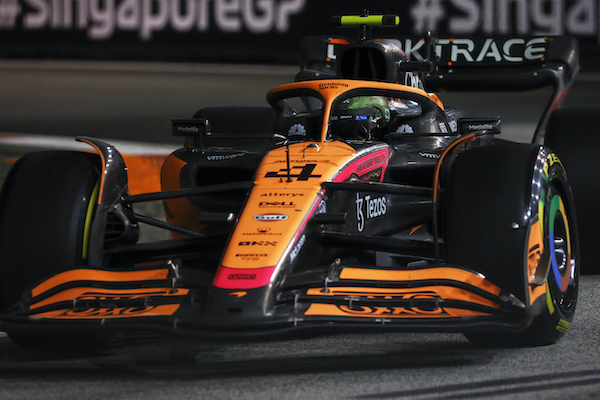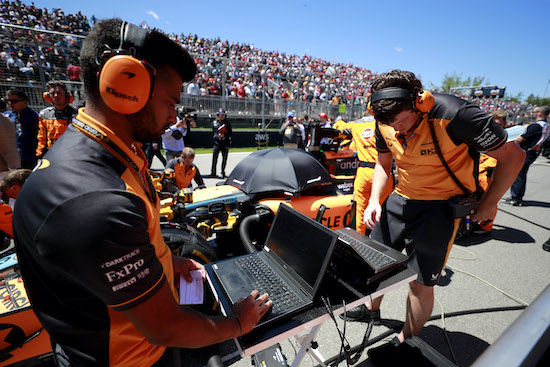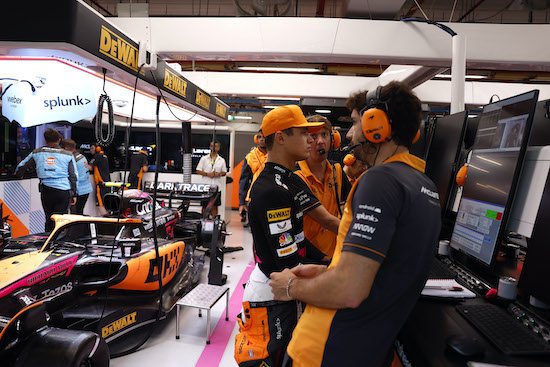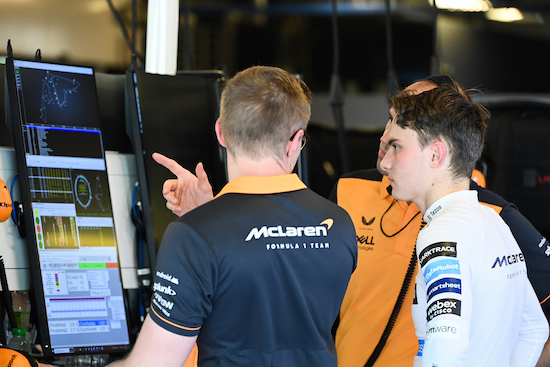Simulation in Overdrive
McLaren Racing relies on Dell Precision workstations and advanced professional GPUs to meet the demanding engineering requirements and rapid pace of change of Formula 1 vehicle design.

McLaren Racing has partnered with Dell Technologies to help optimize its design and simulation operations. Images courtesy of McLaren Racing.
Latest News
January 14, 2023
From an engineering perspective, Formula 1 (F1) racing is one of the most demanding design environments. Margins between the fastest and slowest cars are razor thin (as little as 4%), requiring constant innovation to provide marginal gains in performance.
At Surrey, England-based McLaren Racing, technology plays a key role maintaining competitiveness in their F1 operation as well as the other series they participate in (including IndyCar, Formula E, Extreme E, and esports). The McLaren F1 cars are equipped with 300 sensors that provide 100,000 data points per second to the engineering team. That information is used to inform engineering changes that move at a pace almost as fast as the cars themselves – each car will change by roughly 80% over the course of a season, with a new part finished every seven minutes. The company leverages computational fluid dynamics (CFD) simulation, full-scale digital twins, advanced design software, and Dell Technologies Precision workstations equipped with powerful GPUs to keep its engineering activities on track.
In 2018, McLaren launched a formal partnership with Dell Technologies to support its digital transformation activities, from initial vehicle design to trackside computing, HPC infrastructure, and hybrid/remote workflows. McLaren is using Dell Precision 7770 and Precision 5570 mobile workstations to allow its engineers to handle their design and simulation tasks from anywhere, in combination with highly customized and bespoke design and CFD applications, and tools from MathWorks and Altair, among others, as well as the Dell Alienware virtual reality product.
We spoke to Daniel Keyworth, Director of Business Technology at McLaren Racing, about how the company leverages Dell workstations and GPU compute in its engineering operations, and the challenges of design and manufacturing in the F1 environment.
Please describe the engineering environment at McLaren, and the pace of change for the vehicle designs.
Daniel Keyworth: The early life of a car starts in the aerodynamic department. So, when someone has an aerodynamic idea, that begins in CFD simulation. We create a complete digital twin of a Formula 1 car that allows us to simulate airflow around the car before it is a physical object. Once we are satisfied with those results, we build a 60% scale version of the car and take that to a wind tunnel. We perform simulation activities around that design and feed that information into our driver simulator to give drivers an early indication of what that change may look like. We do all of this before we build a full-scale car, and we must comply with very tight regulations that govern Formula 1 racing.
When you see a car on the track, that is a six-month snapshot of what is in the engineering cycle. However, releasing a change into production and out to the track can happen in a matter of days depending on the activity. We make an engineering change every 15 minutes in the early lifecycle of a car.

What are the biggest business and technology changes and challenges you face?
Keyworth: The McLaren Racing system is forever growing. We are now in five separate championships, and we also have a young driver program. While there are similarities in how we apply technology across those series, there are also all kinds of subtle differences. We must create bespoke technology for each of those series, and there are very specific engineering workflows, so we need to make sure the technology is fit for purpose.
There are also cost cap considerations in Formula 1 and Formula E, so when you are making technology decisions you have to get the biggest bang for your buck. You need to optimize labor and also deliver the highest amount of performance for the least amount of money within your engineering lifecycle.
How has the use of Dell products and the Dell McLaren relationship transformed your business?
Keyworth: We were a customer long before our partnership. We have been on a huge journey specifically around workforce transformation, and how the flow of work happens when you leave the office. That has paid huge dividends, especially when the pandemic happened, and we moved into this context of hybrid working. We were really well prepared for that because we had already gone through these changes that enabled our workforce to operate in a flexible way.
We have also focused on infrastructure and transforming the way that we process and store data at the factory and all the way down to how we deliver technology capabilities at the track. We have a trackside rig and when data comes off the car we process that data, run applications locally at the edge, and stream the data back to the factory. All of that has been delivered by the relationship we have with Dell Technologies.
More recently, we have also worked with them on our CFD activities and stress analysis, and the way we simulate different performance setups for the car. That sits under the banner of HPC and simulation, and we have invested significantly around those capabilities.
On the workstation side, we have a lot of people who travel the world, and we have people working from home. With the Precision 5570, which has the biggest footprint across our team, you can do everything you need to do as a race engineer, but in a much slimmer form factor that is much more flexible and easier to use on the go.

Describe how the Dell workstations and the ability to leverage advanced GPU compute and multicore CPUs has affected your ability to address the simulation challenges of the F1 environment.
Keyworth: We are making engineering changes every 15 minutes. This sport is all about marginal gains, and we are leveraging the concept of in-the-loop data. You make a small change, you get feedback from the simulator, and you need to be able to do the delta analysis between the simulation and the real-world performance accurately. We are in this continuous process of making sure the CFD results are getting closer and closer to what the wind tunnel is telling us and bridging the gap between the physical and digital world.
The new CPUs and GPUs have completely changed the game for us. We have the technology in our hands to keep up with that pace of iteration. We have very intensive applications that are processing lots of data, simulations, modeling and design work. We need both GPU and CPU power to achieve all of those things. Knowing the complexity of the sport, and the complexity of what we do, we have been impressed that the Precision laptops can do all this locally.
With GPU acceleration, we are focused on being as aligned with the industry as possible. That also supports our on-premise infrastructure, which is heavily GPU powered. We can run similar workloads on the workstation or the data center. We take a GPU-led view on application development because it is a trend in the market.
How have changes in F1 regulations changed your design and simulation processes? How has Dell helped address some of those changes?
Keyworth: In 2022, F1 released a new geometry, which has moved to a more ground effect approach to the cars in terms of aerodynamics. Previously, the geometry was more front and rear wing-driven. In 2022 that changed to improve competitiveness and allow closer wheel-to-wheel racing. The ground effect downforce throws all the dirty air higher out of the back of the car, so drivers can get closer to the rear of the other vehicles and allows better racing and more opportunities to pass.
We have had to overhaul our toolsets to accommodate those changes. Dell helped put us on a proactive path. The new geometries were released before 2020, so we had time to get ahead of those changes with our simulation tools. That is when we launched our CFD project with Dell, which involved deploying a new dedicated CFD cluster that allowed us to do more digitally.
That also helped us financially because teams are limited to what they can spend under the Formula 1 cost cap. We are doing more work in a simulation context and were able to get ahead of those changes in the regulations.

Dell has also assisted with the work-from-anywhere approach at McLaren. Can you describe how you leverage both workstation-based and cloud-based tools/workflows?
Keyworth: We are predominantly workstation based, but we have some workloads on premises and virtual desktop infrastructure (VDI). What we love about the Precision line is it is designed with the user in mind, and it allows you to work from anywhere. Even if you look at some of the accessories like the lightweight chargers, which are important when you are on the move. That makes a huge difference because the work we are doing is quite power hungry. Being able to work on the go with good battery life is important.
Can you discuss any future plans that will leverage the Dell hardware to improve operations?
Keyworth: We are focusing on bringing the technology in our other series up to the maturity of the Formula 1 standard. We have built a comprehensive blueprint from an engineering and technology perspective, so we can get an edge in those other series in which we are competing. That will allow our engineers to put their focus on the performance of the car, rather than on developing tools and technology. Applying what we have learned in Formula 1 to the wider racing service system will allow us to compete and win in every racing series.
You can read more about how McLaren Racing uses Dell hardware in this case study.
More Dell Coverage

More NVIDIA Coverage
Subscribe to our FREE magazine, FREE email newsletters or both!
Latest News








